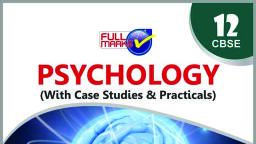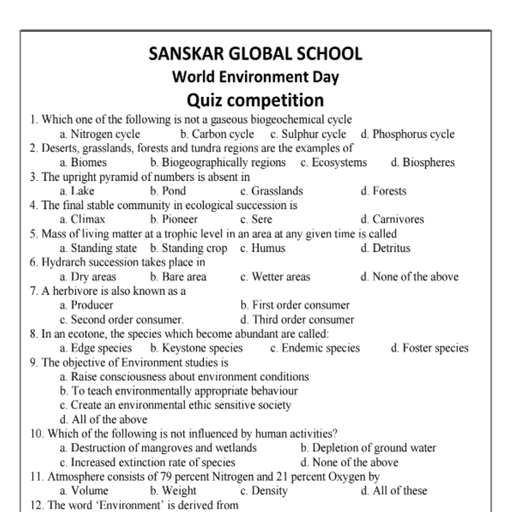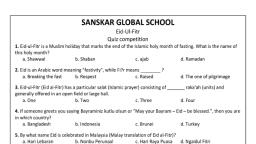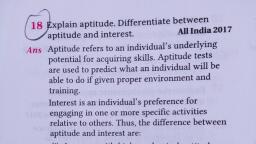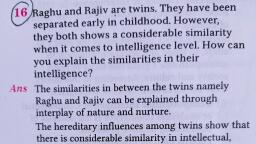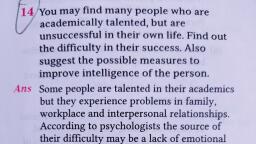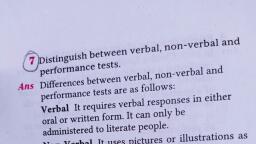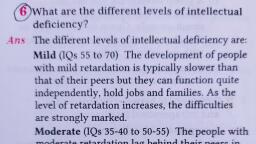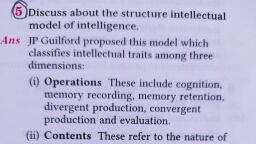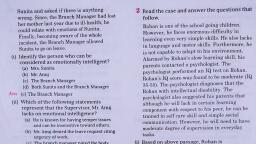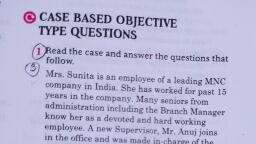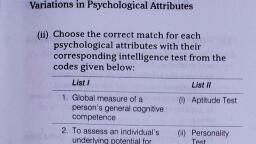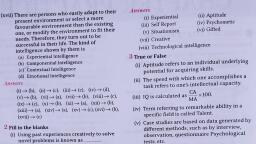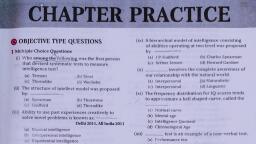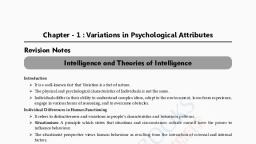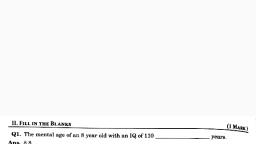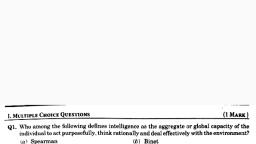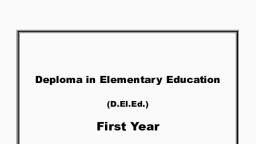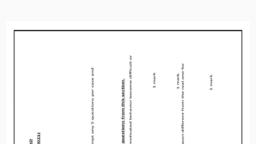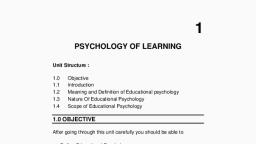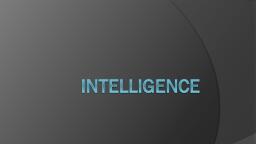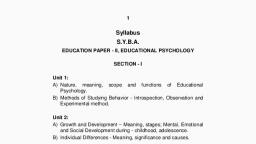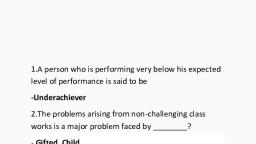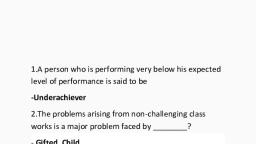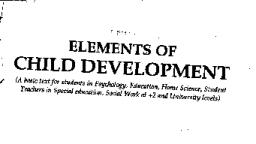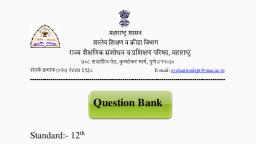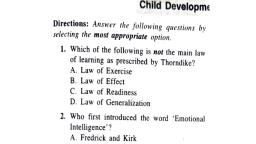Page 1 :
Key Points, , Psychology, , Class - 12th, ( Krishna Singh), , Chp – 1 (Variation in Psychological attributes), What will we learn in this chapter :, 1. How people differ, 2. What brings about these differences, 3. How such differences can be assessed, 1. Individual differences in human psychology :, Individual differences refer to distinctiveness & variations among people’s characteristics and behaviour, pattern., Variability is a fact of nature that occurs on the basis of :, a) Physical dimension :, They differ in height, weight, strength, hair colour, eye colour, skin colour etc), b) Psychological dimension:, Some are intelligent, while some dull, dominant or submissive, creative or non-creative,, introvert or extrovert, could adopt to environment, overcome obstacles, etc., 2. Individual differences:, Distinctiveness and variations among people’s characteristics and behaviour pattern :, a) Personal traits : (Innate, and inborn qualities, due to heredity, etc.), b) Situational factors: Which states that situations and circumstances in which one is placed, had the power to influence one’s behaviour. The Situationist perspective views human, behaviour as resulting from interaction of external factors., 3., , Assessment of psychological attributes : First step to understand a psychological attribute :, It refers to the measurement of psychological attributes of individuals and their evaluation, often, using multiple methods in the terms of certain standards of comparison., It is measured using scientific procedure., , -, , __________________A s s e s s m e n t_______________, |, |, Formal, Informal, Objective, - Varies, Standardized, - Open to subjective, Organized, interpretation, , It helps to predict., Attributes chosen for assessment depends upon the purpose., Psychological assessment uses systematic testing procedures to evaluate abilities, behaviours, and personal qualities of individuals., These tests are widely used for the purposes of clinical, diagnosis, guidance, personnel, selection, placement and training.
Page 2 :
Domain of Psychological Attributes, (Multi Dimensional), , 1., , Psychological, Attributes, Intelligence, , 2., , Aptitude, , 3., , Interest, , 4., , Personality, , Definitions, , Uses of Test, , Global capacity to understand the, world, think rationally and use the, available resources effectively when, faced with challenges., , Provides a global measure of general, cognitive competence including the, ability to profit from schooling. Defines, one’s IQ and his power of, understanding something., Used to predict an individual’s, capacity if given the proper, environment and training., Helps decide what subjects/courses, can be pursued comfortably and with, pleasure., Measures unique characteristics eg., Submissive or dominant, etc. and, explains and predicts future, behaviour., , An individual’s underlying potential, for acquiring skills, in a particular, field., An individual’s preference for, engaging in one or more specific, activities relative to others., Relatively enduring characteristics, of a person that make her or him, distinct from others., , METHODS OF ASSESSMENT, No., 1., , Assessment, Methods, Psychological Test, , 2., , Interview, , 3., , Case Study, , 4., , Observation, , Self-Report, 5., , Definition, , Uses of method, , Objective and standardised measure, of an, Individual’s mental and/or behavioural, characteristics., Seeking information from a person on, a one-to-one basis., , Clinical diagnosis, guidance,, personnel selection, placement, & training., , In-depth study of the individual in, terms of his/her psychological, attributes psychological history in the, context of his /her psychological and, physical environment., Employing systematic, organized and, objective procedure to record, behavioural phenomena occurring, naturally in real time., , Clinical psychologists, based on, data generated using different, methods., , Person provides factual information, about him/herself, opinions, and, beliefs., , Counsellor-client interaction,, employee selection, journalism., , Disadvantages:, 1. Observer has little control, over the situation., 2. Reports may suffer from, subjective interpretations of the, observer., Obtained by an interview, schedule, questionnaire,, psychological test, personal, diary, etc.
Page 3 :
Intelligence, It is the global capacity to understand the world, think rationally and use the available resource, efficiently, when faced with challenges., Common definition : Mental alertness, ready-wit, quickness to learn, grasp & understand., Definition of Oxford Dictionary: Intelligence is the power of perceiving, learning, understanding and, knowing., Theories of Intelligence (Psychological): Classified under 2 categories :, Psychometric Approach, - Considers intelligence as an aggregate of, abilities, - Expresses an individual’s performance in terms, of a single index of cognitive abilities., - Focus on knowing the structure of intelligence., , Information Processing Approach, - Describes the processes used in intellectual, reasoning and problem solving, - Focus on how an intelligent person acts,, emphasizes studying cognitive functions, underlying intelligent behavior., , PSYCHOMETRIC APPROACH, 1. Uni/One-Factor Theory (Alfred Binet):, • Definition: The ability to judge well, understand well, and reason well., • First psychologist who formalised the concept of intelligence in terms of mental operations., • Differentiating more intelligent from less intelligent individuals., • Conceptualised intelligence as consisting of one similar set of abilities which can be used for solving, any or every problem in an individual’s environment., 2. Two-Factor Theory (Charles Spearman) 1927:, , , , , , , , The English Psychologist, Charles Spearman, in 1927 proposed his theory of intelligence called, two-factor theory., According to him intellectual abilities are comprised of two factors, namely :, 1. The general ability known as G-factor and, 2. Specific abilities known as S-factors., Characteristics of G-factor :, - It is universal inborn ability., - It is general mental energy and is constant., - The amount of ‘G’ differs from individual to individual., - It is used in every activity of life., - Greater the ‘G’ in an individual, greater is his success in life., Characteristics of S-factor :, - It is learned and acquired in the environment., - It varies from activity to activity in the same individual., - Individuals differ in the amount of ‘S’ ability.
Page 4 :
3. Theory of Primary Mental Abilities (Louis Thurstone):, He pointed out that there were Seven primary Mental Abilities (later on he added two more)., 1. Verbal Comprehension Factor:, - This factor involves a person’s ability to understand verbal material, grasping meaning, of words, concepts, and ideas., - It is measured by tests such as vocabulary and reading comprehensions., 2. Verbal Fluency Factor:, - This ability is involved in rapidly producing words, sentences and other verbal material., - It is measured by tests such as one that requires the examinee to produce as many, words as possible beginning with a particular letter in a short amount of time., 3. Numerical Factor:, This ability is involved in rapid arithmetic computation and in solving simple arithmetic, word problems., 4. Perceptual speed factor:, - This ability is involved in proofreading and in rapid recognition of letters and numbers., - It is measured by tests such as those requiring the crossing out of as in a long string of, letters or in tests requiring recognition of which of several pictures at the right is, identical to the picture at the left., - It helps to speed in perceiving details, 5. Inductive Reasoning Factor:, - This ability requires generalization – reasoning from the specific to general., - It is measured by tests such as letter series, number series and word classifications, in, which the examinee must indicate which of several words does not belong with the, others., 6. Spatial Visualization Factor:, - This ability is involved in visualizing shapes, rotations of objects and how pieces of a, puzzle fit together., - An example of a test would be the presentation of a geometric form followed by several, other geometric forms., - Each of the forms that follow the first is either the same rotated by some rigid, transformation or the mirror image of the first form in rotation., - The examinee has to indicate which of the forms at the right is a rotated version of the, form at the left, rather than a mirror image., - It helps in visualizing patterns and forms., , 7. Memory Factor:, - It means the ability to recall and associate previously learned items effectively or, memorize quickly.
Page 5 :
4. Hierarchical Model of Intelligence (Arthur Jensen):, Abilities operates at two levels:, , , , Level 1 – Associative learning.(output is equal to input - rote memory), Level 2 – Cognitive competence. (output is more than input), , 5. Structure of Intellect Model (J.P. Guilford) 1988:, • Classifies intellectual traits among three dimensions — operations, contents and products., He proposed Cubic model of the structure of intelligence. Each cube represents an intersection, of operations, contents and products to create 180 components of intelligence ( 6 x 5 x 6 = 180 ), Three separate factors make up any individual activity :, 1. Operations ( 6 ) - What the respondent does, - Cognitive, - Memory recording, - Memory Retention, - Divergent productions, - Convergent productions, - Evaluation, 2. Contents ( 5 ) - the nature of information on which intellectual operations are performed., - Visual, - Auditory, - Symbolic, - Semantic, - Behavioural, 3. Products ( 6 ) - the form in which information is processed by the respondent., - Units, - Classes, - Relations, - Systems, - Transformations, - Implications, , Information-Processing Approach:, 1. Theory of Multiple Intelligences (Howard Gardner):, • Intelligence is not a single entity; distinct types of intelligences exist independent of each other., • Different types of intelligences interact and work together to find a solution to a problem., • Studied persons who had shown exceptional abilities in their respective areas and described eight, types of intelligence.
Page 6 :
(i), , Linguistic: The capacity to use language fluently and flexibly to express one’s thinking and, understand other. Persons high on this ‘word-smart’, eg, poets and writers., , (ii), , Logical-Mathematical: Skills in problem solving, thinking logically and critically and abstract, reasoning , eg, scientists., , (iii), , Spatial: The abilities involved in forming, using and transforming mental images (visual images, and patterns), eg, sculptors, painters, architects, interior decorators., , (iv), , Musical: The capacity to produce, create and manipulate musical rhythms and patterns., , (v), , Bodily-Kinaesthetic: The use of the whole body or portions of it creatively and flexibly for, display, construction of products and problem solving, eg, athletes, dancers, actors., , (vi), , Interpersonal: Skill of an individual to understand the needs, motives feelings and behaviours of, other people for better understanding and relationship. High among psychologists, counsellors, politicians., , (vii), , Intrapersonal: Refers to the awareness of one’s own feelings, motives, desires, knowledge of, one’s internal strengths and limitations and using that knowledge to effectively relate to others,, eg, philosophers., , (viii), , Naturalistic: Complete awareness of our relationship with the natural world and sensitivity to the, features of the natural world, eg, botanists, zoologists., , 2. Triarchic Theory of Intelligence (Robert Sternberg) 1985:, • Definition: The ability to adapt, to shape and select environment to accomplish one’s goals and those, of one’s society and culture., • Three Basic Types of Intelligence:, (i) Componential Intelligence/Analytical Intelligence: The analysis of information to solve problems, Three components:, (a) Knowledge Acquisition - responsible for learning and acquisition of the ways of doing things., (b) Meta or Higher Order Component - planning concerning what to do and how to do it., (c) Performance Component - actually doing things., (ii) Experiential/Creative Intelligence: Using past experiences creatively to solve novel problems., - Ability to integrate different experiences in an original way to make new discoveries and, inventions., - Quickly find out what information is crucial in a given situation., (iii) Contextual/Practical Intelligence: The ability to deal with environmental demands encountered on, a daily basis., - May be called ‘street smartness’ or ‘business sense’, - Easily adapt to their present environment/select a more favourable environment, modify the, environment to fit their needs.
Page 7 :
3. Planning, Attention-arousal and Simultaneous-Successive (PASS) Model of Intelligence, (J.P. Das, Jack Nagliery, Kirby) 1994., • Intellectual activity involves the interdependent functioning of three neurological systems, called the, functional units of brain, • These units are responsible for:, , (i) Arousal/Attention:, - Arousal and attention enable a person to process information., - An optimal level of arousal focuses our attention to the relevant aspects of a problem., - Too much or too little arousal would interfere with attention and attend to stimuli., (ii) Simultaneous and Successive Processing:, - Simultaneous: Perceive the relations among various concepts and integrate them into a, meaningful pattern for comprehension, e.g., RSPM., - Successive: Remember all the information serially so that the recall of one leads to the, recall of another, e.g., learning of digits, letters., ., (iii) Planning:, - Allows us to think of the possible courses of action, implement them to reach a target, and, evaluate their effectiveness., - If a plan does not work, it is modified to suit the requirements of the task or situation., • These PASS processes operate on a knowledge base developed either formally (by reading, writing,, and experimenting) or informally from the environment., • These processes are interactive and dynamic in nature, yet each has its own distinctive function., Cognitive Assessment System (CAS) (Das and Naglieri)., • Battery of tests meant for individuals between 5-18 years of age., • Consists of verbal as well as non-verbal tasks that measure basic cognitive functions presumed to be, Independent of schooling., • Results of assessment can be used to remedy cognitive deficits of children with learning problems., , Individual Differences in Intelligence:, The evidence for hereditary influences on intelligence comes mainly from studies on twins and adopted, children., Relationship, , Reared Together, , Reared Apart, , Identical twins, , 0.90, , 0.72, , Fraternal twins, , 0.60, , -, , Siblings, , 0.50, , 0.25
Page 8 :
CORRELATION OF INTELLIGENCE:, , , Separated early in childhood - show considerable similarity in their intellectual, personality and, behavioural characteristics., , , , Adopted Children - children’s intelligence is more similar to their biological rather than adoptive, parents., , , , Role of Environment - as children grow in age, their intelligence level tends to move closer to, that of their adoptive parents., , , , Disadvantaged Children - adopted into families with higher socio-economic status exhibit a, large increase in their intelligence scores., 1. Environmental deprivation lowers intelligence while rich nutrition, good family background, and, quality schooling increases intelligence., 2. There is a general consensus among psychologists that intelligence is a product of complex, interaction of heredity (nature) and environment (nurture)., 3. Heredity sets a range within which an individual’s development is actually shaped by the, support and opportunities of the environment., , Assessment of Intelligence, 1905: Alfred Binet and Theodore Simon made the first successful attempt to formally measure, intelligence., 1908: Gave the concepts of:, - Mental Age (MA) is the measure of a person’s intellectual development relative to, people of her/his age-group., - Chronological Age (CA) is the biological age from birth., - Retardation was being two mental age years below the chronological age., 1912: William Stern, a German psychologist, devised the concept of Intelligence Quotient (IQ)., IQ refers to ratio between MA and CA. Formula:, Mental age divided by chronological age, and multiplied by 100, (to avoid the decimal point)., • Average IQ in the population is 100, irrespective of age., • Frequency distribution for the IQ scores tends to approximate a bell-shaped curve, called the, normal curve - symmetrical around the central value, called the mean., Range, , Category, , Below 70, , Mental Retardation, , 90 – 110, , Normal Intelligence, , Above 130, , Intellectual Giftedness
Page 9 :
VARIATIONS IN INTELLIGENCE:, 1. Intelligence Deficiency (Mentally Retarded/Challenged):, The American Association on Mental Deficiency (AAMD) views mental retardation as significantly, sub-average general intellectual functioning existing concurrently with deficits in adaptive, behaviour and manifested during the developmental period., In order to be judged as mentally retarded, a person must show:, (i) Significantly sub average intellectual functioning, e.g., IQ below 70., (ii) Deficits in adaptive behaviour or the capacity to be independent and deal effectively, with one’s environment., Deficits must be observed during the developmental period, i.e., between 0-18 years., IQ Range, , Retardation, , 55 – 69, , Mild, , 40 – 54, , Moderate, , 25 – 39, , Severe, , Below 25, , Profound, , Mild retardation - development is typically slower than that of their peers but they can function quite, independently, hold jobs and families., Level of retardation increases - lag behind their peers in language and motor skills, need to be trained in, self-care skills and simple social and communication skills., 2. Intellectual Giftedness:, Lewis Terman (1925): Study to show how intelligence was related to occupational success and life, adjustment. These individual show higher performances because of their outstanding potentialities., Giftedness is exceptional general ability shown in superior performance in a wide variety of areas., Teacher’s perspective: depends on a combination of high ability, high creativity and high, commitment., , , Early signs of intellectual superiority: during infancy show larger attention span, good memory,, sensitivity to environmental changes, early appearance of language skills., , , , Other characteristics are advanced logical thinking and problem solving, high speed in, processing information, high-level creative thinking, high self-esteem, independence., , , , Incorrect to equate with brilliant academic performance: each gifted student possesses different, strengths, personalities and characteristics, e.g., athletes., Talent refers to remarkable ability in a specific field, e.g., social, and are often called prodigies.
Page 10 :
Types of Intelligence Tests, Individual or Group Test:, Group, , Individual, , Can be administered to several persons, simultaneously., Do not allow an opportunity to be, familiar with subject’s feelings., Seek written answers in a MCQ format., , Can be administered to one person at a time., Require the test administrator to establish a, rapport with the subject., Allow to answer oral/written answers or, manipulation of objects., , Culture-Fair or Culture-Biased Tests, Culture Biased, , Culture Fair, , Show a bias to the culture developed in, type of questions and language, , Can be applied meaningfully to all cultures, Culturally appropriate – does not discriminate, against individuals of different cultures., , Verbal, Non-verbal or Performance Tests, Verbal, Require verbal responses in, either oral or written form., , Non-Verbal, Use pictures or illustrations, as test items, e.g. RSPM., , Can only be administered to, literate people., , Performance, Require subjects to manipulate, objects to perform a task; written, language not necessary for, answering., Can be easily administered to, persons from different cultures., , CULTURE AND INTELLIGENCE, A major characteristic of intelligence is that it helps individuals to adapt to their environment. The, cultural environment provides a context for intelligence to develop., Culture is a collective system of customs, beliefs, attitudes and achievements in art and, literature., Sternberg:, • Notion of contextual or practical intelligence implies that intelligence is a product of culture., Vygotsky (Russian psychologist):, • Culture provides a social context in which people live, grow and understand the world around, them., • Elementary mental functions (e.g., walking, crying) are Universal; the manner in which higher, mental functions such as problem-solving and thinking operate are largely culture produced.
Page 11 :
Technological Intelligence, , Integral Intelligence, , Technologically advanced societies., , Less developed societies., , Personal achievement founded on abilities of, reasoning and judgement are emphasized., Focus on cognitive parameters – persons, are well versed in skills of attention,, observation, analysis, performance, speed and, achievement orientation., , Social and emotional skill in relating to, people is valued., Holistic perspective, emphasized connectivity, with the social and world environment., , Equal attention given to cognitive and non-cognitive processes and their integration:, (i) Cognitive capacity (sensitivity to context, understanding, discrimination, problem-solving, and effective communication)., (ii) Social competence (respect for social order, commitment to elders, the young and the, needy, concern about others and recognising others perspectives)., (iii) Emotional competence (self-regulation and self-monitoring of emotions, honesty,, politeness, good conduct and self-evaluation)., (iv) Entrepreneurial competence (commitment, persistence, patience, hard work, vigilance, and goal-directed behaviour)., EMOTIONAL INTELLIGENCE:, Emotional intelligence is a set of skills that underlie accurate appraisal, expression and regulation, of emotions. It is the feeling side of intelligence., (i) Emotional Quotient (EQ) is used to express emotional intelligence in the same way as, IQ is used to express intelligence., (ii) Salovey and Mayer: The ability to monitor one’s own and other’s emotions, to, discriminate among them and to use the information to guide one’s thinking & actions., SPECIAL ABILITIES:, Aptitude indicates an individual’s capacity to acquire some specific knowledge or skill after, training., (i) People with similar intelligence differed widely in acquiring certain knowledge or skills,, called aptitudes., (ii) With proper training, these abilities can be considerably enhanced., , Interest is a preference for a particular activity; aptitude is the potentiality to perform that activity., (i) In order to be successful in a particular field, a person must have both aptitude and interest., Aptitude Tests, Independent (Specialized), Clerical, mechanical, numerical and typing, aptitude tests., , Multiple (Generalized), Differential Aptitude Test (DAT), General, Aptitude Test Battery (GATB).
Page 12 :
• Creativity refers to the ability to produce ideas, objects and problem solutions that are novel and, appropriate., • It refers to the ability to think in novel and unusual ways and to came up with unique solutions to, problems., • Creativity involves the production of same thing new and original it may be an idea, object or, solution to a problem., • Creativity can get manifested in different levels and in different areas., • Everyday creativity/Day to day creativity. It could be reflected in day to day activities like writing,, teaching, storytelling, flower arrangement, dance etc., • Special talent creativity/Higher order creativity. It is related to outstanding creative, achievements e.g. inventions and discoveries., • Creativity is always reality oriented, appropriate, constructive and socially desirable., • Everyday creativity could be seen in terms of the level and the areas in which they exhibit, creativity and that all may not be operating at the same level., • Researches suggest that children mostly express their imagination through physical activities, and in non-verbal ways, although when language and intellectual functions are fully developed, and store of knowledge is adequately available then creativity is expressed through verbal, modes too., • There is no disagreement that creativity in determined by both heredity and environment., • Limits of the creative potential are set by heredity., • Environmental factors stimulate the development of creativity., • No amount of training can transform an average person to develop special talent creativity or, higher order creativity like Tagore, Einstein or Shakespeare., CREATIVITY AND INTELLIGENCE:, • Certain level of intelligence in necessary to be creative, but a high level of intelligence, however, does not ensure that a person would certainly be creative., • Researchers have found that both high and law level of creativity can be formed in highly, intelligent children and also children of average intelligence., • Relation between creativity and intelligence is positive., , , , , , , , Creativity Tests, These tests use open ended questions., Maximum scope to assess expression of, spontaneity, originality and imagination., Focus on divergent thinking., GUILFORD, KHATANA, PARAMESH., See relationships between unrelated, things, , , , , , , , Intelligence Tests, These tests use close ended questions., Measure abilities which involve, convergent thinking., Focus on assessing abilities., BAQER MEHDI and PASSI developed, creativity tests., Person has to think right solution.
Page 13 :
• Aptitude: A combination of characteristics indicative of individual’s potential to acquire some, specific skills with training., • Aptitude Tests: Tests meant to measure individual’s potential to predict future performance., • Beliefs: The cognitive component of the thoughts or ideas regarding a topic., • Case Study: An intensive study of an individual or a situation to develop general principles, about behaviour., • Cognition: The process of knowing. The mental activities association with thought, decision, making, language, and other higher mental processes., • Cognitive Assessment System: A battery of tests designed to measure the four PASS, (Planning-Attention-Simultaneous-Successive) process., • Componential Intelligence: In Sternberg’s triarchic theory, it refers to ability to think critically, and analytically., • Contextual Intelligence: In Sternberg’s triarchic theory, it is the practical intelligence used in, solving everyday problems., • Creativity: The ability to produce ideas, objects, and problem solutions that are novel and, appropriate., • Culture-fair Test: A test that does not discriminate examinees on the basis of their culture, experiences., • Emotional Intelligence: A cluster of traits or abilities relating to the emotional side of life, abilities such as recognising and managing one’s own emotions, being able to motivate oneself, and restrain one’s impulses, recognising and managing others’ emotions, and handling, interpersonal relationship in an effective manner. It is expressed in the form of an emotional, quotient (EQ) score., • Experiential Intelligence: In Sternberg’s triarchic theory, it is the ability to use past, experiences creatively to solve novel problems., • Factor Analysis: Mathematical procedure, involving correlations, for sorting trait terms or test, responses into clusters or factors; used in the development of test designed to discover basic, personality traits. It identifies items that are homogeneous or internally consistent and, independent of others., • Fluid Intelligence: Ability to perceive complex relationship, reason abstractly, and solve, problems., • Genetics: The study of how the qualities of living things are passed on in their genes., • Group Test: A test designed to be administered to more than one individual at the same time,, in contrast to individual test., • Individual Differences: Distinctiveness and unique variations among people’s characteristics, and behaviour patterns., • Individual Test: A test that must be given to a single individual at a time, typically by a specially, trained person. The Binet and Wechsler intelligence tests are examples of individual test., • Intellectual Giftedness: Exceptional general intellectual efficiency shown in superior
Page 14 :
performance in a wide range of tasks., • Intelligence: The capacity to understand the world, to think rationally, and to use resources, efficiency when faced with challenges., • Intelligence Quotient (IQ): An index derived from standardised intelligence tests, indicating a ratio of mental age to chronological age., • Intelligence Test: Test designed to. measure person’s level of intelligence., • Interest: An individual’s preference for one or more specific activities., • Interview: Purposeful conversation through face to face interaction., • Mental Age (MA): A measure of intellectual functioning combined with varying degrees of, deficits in adaptive behaviour., • Mental Retardation: Sub-average intellectual functioning combined with varying degrees, of deficits in adaptive behaviour., • Normal Probability Curve: A symmetrical, bell-shaped frequency distribution. Most scores are, found near the middle and fewer and fewer occur towards the extremes. Many psychological, characteristics are distributed in this manner., • Norms: Standards of test performance that permit the comparison of one person’s score on the, test to the scores of others who have taken the same test., • Observational Method: Employing systematic, organised and objective procedures to record, behavioural phenomena occurring naturally in real time., • Observation method: Employing systematic organised and objective procedures to record, behavioural phenomena occurring naturally., • Performance Test: A test in which the role of language is minimised, the task requiring overt, motor responses other than verbal., • Planning: In Das PASS model of intelligence, it involves goal setting, strategy selection, and, monitoring of goal-oriented., • Problem-solving Behaviour: The activity and mental processes involved in overcoming the, obstacles, physical or conceptual, which lie between an animal and its goal., • Psychological Test: An objective and standardised in instrument for measuring an individual’s, mental and behavioural traits; used by psychologists to help people make decisions about their, lives and understand more about themselves., • Self-awareness: Insight into one’s own motives, potential and limitation., • Sensitivity: Tendency to respond to very low levels of physical stimulation., • Simultaneous Processing: Cognitive processing in the PASS model that involves integrating, elements of the stimulus situation into composite and meaningful patterns., • Situationism: A principle which states that situations and circumstances outside oneself have, the power to influence behaviour.
Page 15 :
• Successive Processing: Cognitive processing in the PASS model where elements of the, stimulus situation are responded to sequentially., • Values: Refers to the enduring beliefs about an ideal made of behaviour., • Verbal Test: Test in which a subject’s ability understand in making and use words and, concepts is important in paking the required responses.



